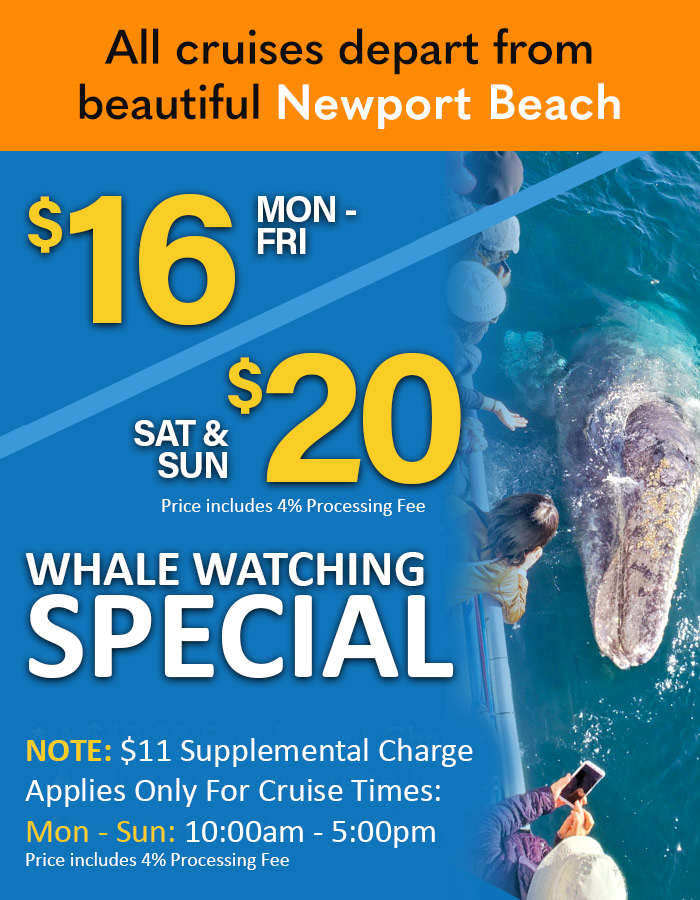
Whale Watching Los Angeles Visitors $16
Information for Los Angeles Residents and Visitors
Davey’s Locker Offers Daily Departures Year Round
For those visiting Los Angeles, Davey’s Locker whale watching cruises often end up as one of the favorite activities while in LA. Along with the pricing and schedule, Davey’s Locker has provided recommended hotels for those staying in Los Angeles as well as popular attractions and other activities that Los Angeles whale watchers might find to be a neat addition while visiting Los Angeles.
Buy tickets online or call (949) 673-1434 to schedule a cruise
Approximately 35 minutes from downtown Los Angeles, Davey’s Locker has provided whale watching to Los Angeles area visitors for over 30 years from one of the closest natural harbors to the city of Los Angeles, in Newport Bay. Marine life flourishes in the pristine waters just outside the bay’s entrance. It is not uncommon to see giant blue whales and finback whales just outside the bay during the summer and fall months. Multiple gray whales are often seen in this same area during the winter and spring months while on their annual migration. >> Check out the Whale Watching Cruise Times & Pricing Info.
Best Times Of The Year For Whale Watching In LA
There is really no better time of year for whale watching, as whales can be spotted throughout the year in Southern California and the Greater Los Angeles region.
Year-round we can spot Humpback Whales, Finback Whales, Minke Whales and a variety of dolphin.
From January through May we actively spot California Gray Whales. Gray Whales make an extensive migration during the winter and spring from the Chukchi and Bering Sea’s in Alaska down to three wintering lagoons in Baja Mexico. On the way down to Mexico, a majority of pregnant females end up giving birth just above Los Angeles and swim down along the coast with their small babies in tow. Around 20,000 Grays are moving up and down the coast during this time of year, which makes it a great time for whale watching.
The Blue Whale season starts in early summer. June through September we see one of the largest animals that have ever lived on the planet, feeding on krill and swimming right off the LA coast. These magnificent creatures weigh in at nearly 400,000lbs and stretch to lengths of close to 100ft long!
So anytime you want to go whale watching in Los Angeles during the year your chances of spotting whales are very high!
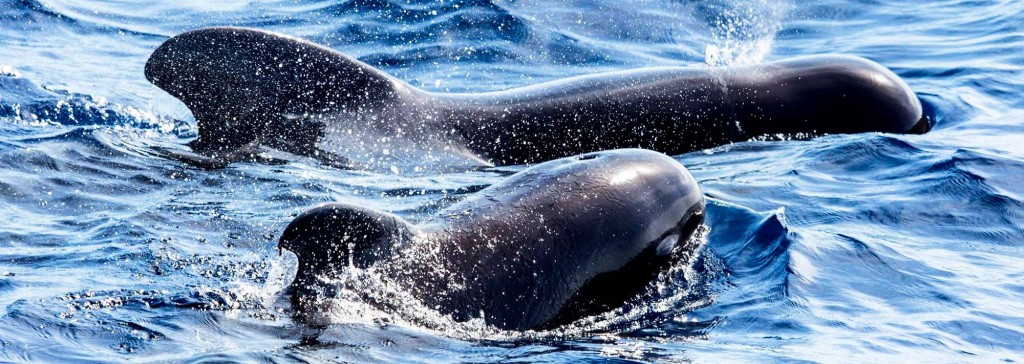
The Evolution of Southern California Whale Watching – With Year Round Options!
Whale watching is the practice of observing whales and other cetaceans in their natural habitat. Whales are watched most commonly for recreation, but the activity can also be for scientific or educational reasons. Whale watching as an organized activity dates back to 1950 when the Cabrillo National Monument in San Diego was declared a public spot for the observation of Gray Whales. In 1955 the first water-based whale watching commenced in the same area, charging customers $1 per trip to view the whales at closer quarters. The spectacle proved popular, attracting 10,000 visitors in its first year and many more in subsequent years. Southern California whale watching was the birthplace for whale watching throughout the globe.
Throughout the 1980’s and 1990’s whale watching spread throughout the world. In 1998 Erich Hoyt carried out the largest systematic study of whale watching yet undertaken and concluded that whale watching trips were now available in 87 countries around the world, with over 9 million participants generating an income to whale watcher operators and supporting infrastructure (such as accommodation, restaurants and souvenirs) of over one billion dollars. His estimate for 2000 was for 11.3m participants spending $1.475bn, representing a five-fold increase over the decade.
For 40+ years the Gray Whale has been California’s state marine mammal. If you were to speak to one of our boat captains 25 years ago, and asked “What’s the best time to come see whales?” they would have told you “Only during the Gray Whale migration in January through May.” And they were right! Not many companies were running year round whale watching at that time and, from what the boats reported, whale sightings were scarce. It was not until the 1990’s that people realized Humpback and Blue Whale populations were moving up and down California coast at other times of the year (summer season). As the number of whale sightings started to increase, it lead to more companies offering year round whale watching in the Los Angeles area.
Helpful Hints to Maximize Your Whale Watching Experience
What’s the best time of day to go whale watching?
Los Angeles is about 40-60 minutes from Newport Beach, an ideal location for whale watching. A question we get most often is, “what’s the best time of day for whale watching?” My favorite cruise times for Los Angeles whale watching visitors is the noon or 1pm cruise time and the 3:30pm departure time, as traffic is usually good and whales are often located on the earlier trips, meaning your cruise can spend more time viewing the whales and less time trying to locate them!
When should I arrive for my scheduled reservation & where should I park?
Please try to arrive at least 30 minutes before your cruise departure time. If you need help with directions or parking please visit our parking and directions page at https://daveyslocker.com/contact-us-directions/
What are some things I should bring onboard?
- Water Bottle
- Sun protection, such as sunscreen and a hat
- Light jacket
- Camera (recommended)
- Cash if you want to purchase light snacks or drinks from the galley
- Rent or bring binoculars
Checking the weather for Los Angeles and surrounding areas beforehand can be helpful in figuring out what would be best to wear, as it can get cold out on the water.
Please do not bring the following items on the boat: glass containers, outside alcohol, hard plastic coolers, and strollers.
What if I get motion sickness?
We typically don’t have many issues with this, but if you know you are prone to motion sickness a helpful tip would be to take Bonine or Dramamine AT LEAST 1 hour before you board the vessel. What has worked well for some is to take the motion sickness pill the night before your trip. Then when you wake up in the morning, take one more pill, that way you can combat any drowsy affects the motion sickness pill might have on you. These work great, and we also sell them in our office if you do not have time to pick them up on your way here.
Another option is wearing Sea-Bands which are a knitted elasticated wrist band, which works by applying pressure on an acupressure point on each wrist by means of a plastic stud. Because the bands do not use drugs, they do not cause any of the side effects associated with anti-nausea drugs and can be worn on each wrist whenever you feel nauseous. They are suitable for adults and children.
Those who prefer an herbal remedy may look into eating or chewing on ginger or ginger flavored candy, which can help relieve nausea.
Whale Species You Can See Whale Watching In Los Angeles
Baleen Whales
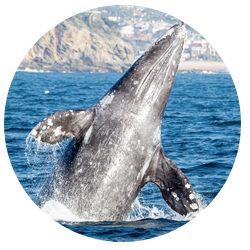
Gray Whales
(Eschrictius robustus)The gray whale is a baleen whale. It migrates between feeding and breeding grounds yearly and makes one of the longest annual migrations of any mammal, traveling some 5,000 miles each way from its northern feeding grounds in Alaska to its breeding and calving grounds in the warm lagoons of Baja Mexico. Gray whales can reach about 49ft long and weigh up to 72,000lbs.
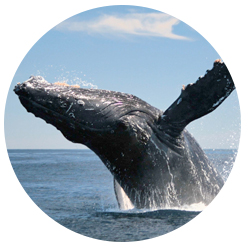
Humpback Whales
(Megaptera novaeangliae)The humpback whale is extremely maneuverable and the acrobat of the whale world. Humpbacks can measure 40-50ft long (females are usually larger than males) and can weigh up to 80,000lbs. They feed mainly on small shrimp-like crustaceans commonly known as krill, other zooplankton and small schooling fish. Humpback whales are widely distributed over all the oceans from the poles to the topics, but there are distinct seasonal changes in their distribution. While whale watching in Los Angeles, you can see these animals year round.
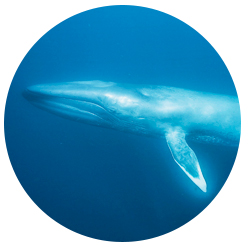
Blue Whales
(Balaenoptera musculus)Blue Whales are one of the largest creatures to ever live on our planet! The average size of a blue whale is 80-90ft, with the largest recorded whale measured 110ft (that’s the size of two school buses parked end to end!) Blue whales are found in all oceans, and in the western Pacific Ocean, blue whales range from Gulf of Alaska, which is an area rich in food, all the way to Costa Rica, where it is believed they migrate to bread and have their young. Blue whales are currently listed as endangered animals with only about 2,500 left in the North Pacific population.
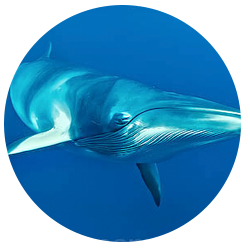
Minke Whales
(Balaenoptera acutorostrata)Minke Whales typically prefer cold and icy waters, and are rarely observed in the tropics. They are the smallest of the baleen whale family, only reaching about 27ft long. They have a small, weak, but visible, bushy blow that is about 6.5-10 feet high, but because they do not display their flukes when diving they are sometimes hard to find.
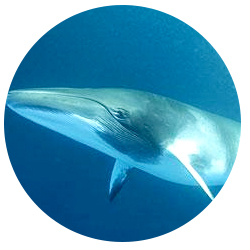
Fin Whales
(Balaenoptera physalus)The Fin whale is a member of the rorqual family, which includes Humback whales, Minke whales, Blue whales, Bryde’s whales and Sei whales. The Fin whale is the second largest species of whale, the first being the Blue whale. They are very fast swimmers, capable of bursts of up to 23 mph, leading to its description as the “greyhound of the sea.” These whales can reach over 85ft long and can weigh between 100,000-140-000 lbs. Fin whales are very long lived with an average life span of 85-90 years old!
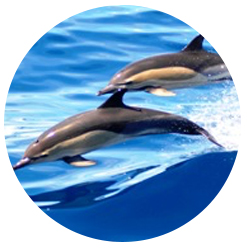
Common Dolphin
(Delphinus delphis)There are two species of Common Dolphin, the short-beaked common dolphin and the long-beaked common dolphin (both seen in here whale watching in Los Angeles). They are found in the North and South Pacific and Indian oceans, and are widely distributed in warmer temperate and tropical waters of all the oceans of the world. Both common dolphin adults range between 5 ft-5.5ft long, and can weigh about 300lbs. They are very fast swimmers, reaching speeds of up to 29 miles per hour, averaging about 100 miles per day, which is one of the reasons these dolphins don’t do well in captivity. Dolphins have a unique adaptation called echolocation. They create a series of clicking sounds, made from a specialized organ under the blowhole. These clicks are sent out of the melon and are like an ultrasound machine. They bounce off objects, and the information is sent back to the dolphin to create an image.
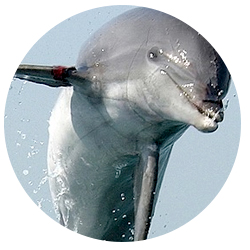
Bottlenose Dolphin
(Tursiops Truncatus)The bottlenose dolphin have a short stubby beak- hence the name “bottlenose.” The common bottlenose dolphin is the most familiar of the family of whales and dolphins (cetaceans) because of its coastal occurrence around the world and its prevalence in zoos and aquariums. Adults range between 8-12ft and may weigh as much as 1,430lbs. Bottlenose dolphins can reach speeds in excess of 18 miles per hour, and they have an average lifespan in the wild of about 30-40 years. Scientists working with the Aquarium of the Pacific in LA run a coastal bottlenose dolphin survey year round to help monitor and understand more about the bottlenose dolphin and its behavior.
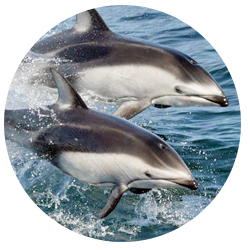
Pacific White Sided Dolphin
(Lagenorthynchus obliquidens)Pacific white-sided dolphin is dark grey or black in coloration. As its name suggests, it has a greyish side patch which extends down the sides to just below the dorsal fin. These dolphin reach a length of 7-8 feet and weigh about 300lbs. Pacific white-sided dolphins are extremely agile, acrobatic and social. Generally traveling in groups of tens or hundreds of individuals, they can be seen in herds of 2,000 or more.
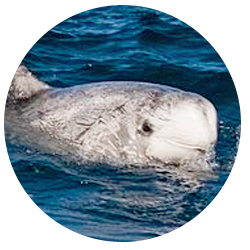
Risso’s Dolphin
(Grampus griseus)Risso’s dolphin is named after Antoine Risso, whose description formed the basis of the first public description of the animal. They usually weigh between 650-1100lbs and are about 10ft in length. These animals primarily feed on small schooling fish and squid, and when we have lots of bait in the area, these curious dolphin make an appearance.
Rare Species Seen off the Los Angeles Coast
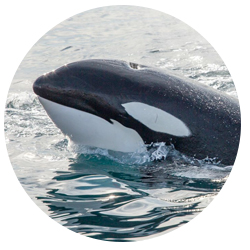
Orcas or Killer Whales
(Orcinus Orca)Orcas are the best known of any whale, as they have been extensively studied in the wild and in sea parks and aquariums. Killer whales most widely distributed marine mammals, found in all parts of the oceans; most abundant in colder waters, including Antarctica, the North Atlantic and Pacific Oceans. Orcas are the largest member of the dolphin family, with the males growing as large as 32ft, weighing 8-9 tons. Females can reach 23ft long and can weigh up to 4 tons. We have seen them while on whale watching cruises in LA in late Dec-early Jan.
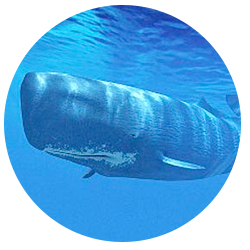
Sperm Whales
(Physeter microcephalus)The sperm whale is the largest of the toothed whales and the largest toothed predator with some whale reaching 67ft. They are found in very deep, pelagic ocean environments. Whale watching in Los Angeles, our last encounter with Sperm Whales was in October of 2014.
Bryde’s Whales
(Balaenoptera brydei)Bryde’s whales, pronounced brewtus, are baleen whales. They are also difficult to identify until one is close enough to see the number of ridges on top of the head, as it is very similar to a Fin whale, another common species we see year round. The Bryde’s whale is smaller, and the adult male measures 40 to 50 feet and weighs about 26,000lbs. These whale venture beyond 40 degree north or south, and are most common in tropical and sub-tropical waters. We usually see these tropical whales in mid-summer or during an extreme period of warming in our local waters.
Pilot Whales
(Globicephala macrorhynchus)The pilot whale, like the killer whale, is a member of the dolphin family, and is second only to the killer whale in size.The pilot whale feeds primarily on squid, although it’s known to eat octopus, cuttlefish, herring and other small fish when squid is unavailable. When we have lots of bait in the area, and warming local waters, these curious dolphin make an appearance.
False Killer Whales
(Pseudorca crassidens)False killer whales are large members of the dolphin family reaching about 20ft long. In adulthood, false killer whales can weigh approximately 1,500lbs. False killer whales have dark coloration except for some lighter patches near the throat and middle chest. They prefer tropical to temperate waters that are deeper than 3,300 feet. We usually see these tropical whales in mid-summer or during an extreme period of warming in our local waters.
What You Won’t See
What you can’t expect is to see whales where you want them to be exactly when you want them to be there. This is nature, real life; not a multimillion-dollar theme park where every surprise is scheduled. Patience must rule the day. When you do see whales, you will realize they were worth the wait. Also, you will return to shore exhilarated, better educated about a fascinating animal, and more aware of what’s at stake if we lose even one species to extinction.
Sometimes people are disappointed when they first see a whale spout. “That’s it?” they say. “That little puff of steam that the wind blew away?” But when you’ve had a chance to do some whale watching in LA, you will find out that each of the great whales has a distinctive spout. Literally a large roomful of air and mist is exhaled each time a whale breathes. If you’re familiar with the height and shape of the different blows, and if the wind isn’t too strong, and if you’re facing the whale head on, sometimes you can tell exactly what sort of whale you’re seeing even if you don’t get a glimpse of the body or the dorsal fin or some other telltale sign. And sometimes, of course, you can’t.
If you know what to expect, if you know that the great whales range in size from 45 to 90 or 100 feet and weigh as much as 1.5 tons per foot, you’re less likely to be disappointed at the sight of a spout. If you know that a blue whale can weigh as much as thirty-two elephants or that a toddler could crawl through the arteries of any full-grown great whale or that a humpback’s flipper is more than twice the height of the tallest person you know, then your sense of excitement about even a distant sighting will increase. Chances are good – guaranteed at some spots such as Newport Harbor during December thru April for California Grey Whales – that you will see much more than a spout. Take binoculars or rent them, to get a closer look at whales in the distance.
Naturalists on Board
Some trips are strictly for pleasure, some are research oriented, and some successfully combine both elements. Many whale-watch tours are family-run businesses; some are sponsored by scientific institutions and research organizations. Our Greater Los Angeles whale watching cruises combine both elements which makes each cruise an exciting and informative experience. Having a naturalist onboard means there will be extra narration, and information given during the whale watch trips. Some naturalists are marine biologists or oceanographers. Some are affiliated with, and trained by, research organizations and scientific institutions. On some trips, narration is provided by knowledgeable captains, people who have been going to sea with whales for years and have made a point of educating themselves so they can answer passengers’ questions correctly.
Educational Resources
The American Cetacean Society – Los Angeles Chapter: The American Cetacean Society has been dedicated to protecting whales since 1967. ACS, a nonprofit organization, protects cetaceans (whales, dolphins, and porpoises) and their habitats through public education, research grants and conservation activities. They have free lectures, courses to become a certified ACS-LA Naturalist, and have volunteer opportunities to participate in the Gray Whale Census they hold yearly to monitor California Gray Whales.
The Point Vicente Interpretive Center
A free museum open to the public daily from 10am to 5pm in the Los Angeles Area, has lots of interesting information about the peninsula’s geology, flora and fauna. There’s also a large portion of the museum dedicated to whales. The American Cetacean Society of Los Angeles volunteers gather daily at the center from late Nov through May to conduct a census of whales passing through the Catalina Channel. The friendly American Cetacean Society volunteers are happy to talk about whales and invite visitors to observe the Pacific Ocean through their spotting scopes.
An incredible little aquarium with lots of interesting local fish exhibits. A section of the aquarium is dedicated to marine mammals, with a real juvenile Gray Whale skeleton displayed inside!
A comprehensive guide to marine mammal facts & information
Visit our webpage at newportwhales.com/school where you can find pre and post trip activity packets along with whale and dolphin information and additional fun and educational activities listed under “Curriculum Packets.”
Recommended Hotels
| Hyatt Century Plaza Hotel
2025 Avenue of Stars Los Angeles CA 90067 (310) 228-1234 Loews Santa Monica Beach Hotel 1700 Ocean Ave Santa Monica, CA 90401 (310) 458-6700 Millenium Biltmore Hotel 506 S Grand Ave Los Angeles, CA 90071 (213) 624-1011 |
Omni Los Angeles Hotel
251 S Olive St Los Angeles, CA 90012 (213) 617-3300 Intercontinental Los Angeles 2151 Avenue of the Stars Los Angeles, CA 90067 (310) 277-2777 Beverly Wilshire Four Seasons 9500 Wilshire Blvd Beverly Hills, CA 90212 (310) 275-5200 |
Recommended Attractions
| Los Angeles Zoo
5333 Zoo Drive Los Angeles, CA 90027 (323) 644-4200 Getty Museum 1200 Getty Center Drive Los Angeles, CA 90049 (310) 440-7300 La Brea Tar Pits 5801 Wilshire Boulevard Los Angeles, CA 90036 (323) 934-7243 |
Griffith Park Observatory
2800 East Observatory Road Los Angeles, CA 90027 (213) 473-0800 Huntington Library (Library, Art Collections, & Botanical Gardens) 1151 Oxford Road San Marino, CA 91108 (626) 405-2100 |
Recommended Nature & Parks
| Point Vicente Interpretive Center
31501 Palos Verdes Drive West Rancho Palos Verdes (310) 377-5370 Griffith Park 4730 Crystal Springs Drive Los Angeles, CA 90027 (323) 913-4688 Cabrillo Marine Aquarium 3720 Stephen M. White Drive San Pedro, CA 90731 (310) 548-7562 |
Abalone Cove Shoreline Park
5970 Palos Verdes Drive South Rancho Palos Verdes (310) 377-1222 Palos Verde Peninsula Various Parks and Tide Pools |
Book Your Trip Online. $16 Whale Watching Special
For Los Angeles Visitor Whale Watching Coupons, please feel free to sign up for our monthly newsletter & follow us on Facebook. You’ll be kept up to date on all things whale watching Los Angeles, and of course holiday specials and promotions.


